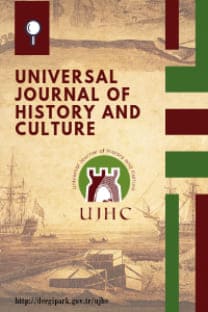Njegos ve Dağ Çelengi: Sırp Milliyetçiliğinin Irkçı Efsanesinin Arkasındaki Metin
Petar Njegos, Katliam, Etnisite, Bosna, Sırbistan, Osmanlı Devleti
Njegos’s The Mountain Wreath: The Text Behind Serbian Nationalism’s Racist Foundation Myth
Petar Njegos, Massacre, Ethnicity, Bosnia, Serbia, The Ottoman Empire,
___
- Andric, I. (1959). The bridge on the Drina. University of Chicago Press.
- Bevan, R. (2006). The destruction of memory: Architecture at war. London: Reaktion Books.
- Cornwell, J. (1999). Hitler’s pope: The secret history of Pius xii. London: Penguin Books.
- Greenawalt, A. (2019). Kosovo myths: Karadzic, Njegos, and the transformation of Serb memory. Retrieved 29.07.2019, from https://digitalcommons.pace.edu/lawfaculty/ 339.
- Hashemipour, S. (2018). A way-out of epistemology: Jewish identity in the ‘thirteenth tribe. The Journal of Organizational Behavior Research, 3(1), 129-147.
- Malcolm, N. (1999). Kosovo: A short history. Harper Collins.
- Naimark, N. M. (2002). Fires of hatred: Ethnic cleansing in twentieth-century Europe. Cambridge,
- Massachusetts, and London: Harvard University Press.
- Pavic, M. (1989). Dictionary of the Khazars: a lexicon novel in 100.000 words. Alfred A. Knopf.
- Popovic, V. (n.d.). Introduction” to Petar II Petrovic Njegos..
- Said, E. W. (1994). Culture and imperialism. London: Vintage.
- Sells, M. (1998). The bridge betrayed: Religion and genocide in Bosnia. Berkeley: UC Press.
- Wachtel, A. B. (1998). Making a nation, breaking a nation: Literature and cultural politics in Yugoslavia. Stanford Univ. Press.
- Wallace, W. L. (1997). The future of ethnicity, race, and nationality. Connecticut: Praeger: Westport.
- ISSN: 2667-8179
- Başlangıç: 2019
- Yayıncı: Orhan TURAN
Olcaytû Han Döneminde İlhanlı Vezirleri ve Devlet İçerisindeki Rolleri
Hristiyandan Öte Ortodoks Hristiyan Bir Millet: Rus İmparatorluğu'nun Tarih Okuması
Eston Bağımsızlık Savaşı Öncesi Eston Kimliğinin ve Eston Milliyetçiliğinin Yükselişi
Bir Tasarım Aracı Olarak Nostalji: Kabataş İskelesi Üzerine Deneme
Kültürel Bellek, Sözlü Kültürden Yazılı Kültüre Hatırlama
Boşnak Edebiyatı ve Kimliği, Küresel Medeniyetin Etkisinin Altında
Njegos ve Dağ Çelengi: Sırp Milliyetçiliğinin Irkçı Efsanesinin Arkasındaki Metin
Bursa Basın Hayatında Hüdâvendigâr Gazetesi
History, Vision and Narrative in Ahdaf Soueif's The Map of Love
Miraslaştırma ve Anma Biçimlerinin Karanlık Yüzü: Kolektif Belleğin Bağlamından Koparılması
